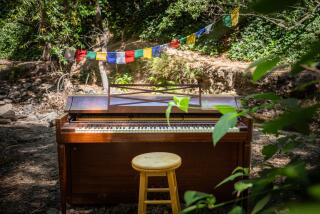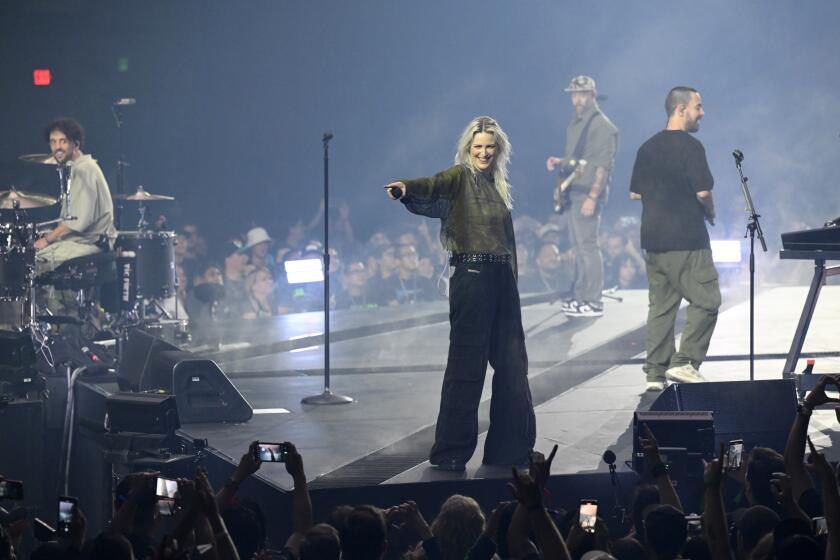Harold B. Rhodes; Inventor of Electric Piano
- Share via
Harold Burroughs Rhodes, a music teacher turned inventor whose revolutionary electric piano became a favorite of jazz and rock musicians, is dead at 89.
Rhodes, who died Dec. 17 in a Canoga Park nursing home of complications from pneumonia, was the creator of the legendary Rhodes electric piano, an instrument that grew from a crude model he fashioned out of airplane scrap during World War II into a classic favored by such performers as Herbie Hancock and Stevie Wonder.
The introduction of the Rhodes piano in 1965 is considered a critical development in the evolution of jazz-rock in the 1970s. It gave the music of artists such as Hancock, Miles Davis and Chick Corea an unexpected mellowness, blended well with other instruments and had a true piano touch.
“Certainly the Rhodes piano was an instrument that had to be available for anything like our music to have happened,” Hancock said in 1975. “I simply couldn’t play the same tunes we’re now doing on an acoustic piano. It just wouldn’t work.”
Rhodes was born in San Fernando, the son of a Realtor and a seamstress. He was exposed to jazz as a child listening to his brother’s phonograph collection and was so intrigued by some of the more unusual chords that he asked for piano lessons. At Polytechnic High School in the San Fernando Valley, he devoured courses in music, as well as in architectural engineering, another passionate interest.
He earned a scholarship to study architecture at USC but dropped out to help support his family when the Depression hit in 1929. Serendipitously, his music teacher had moved out of town and left her students to Rhodes. At 19, he became a piano teacher with nine students. After a few years he developed an approach to music instruction that allowed students to improvise melodies early in their training. By 1940 he was operating a successful chain of piano studios from Los Angeles to New York.
Then World War II came along. Although Rhodes was assigned to flight instructor training in the Army, he gave piano lessons to his buddies to kill time. The lessons became so popular that a surgeon at the base hospital in Greensboro, N.C., talked him into teaching piano to injured soldiers as part of their rehabilitation.
Rhodes enthusiastically accepted. But there was one problem: He could not find a piano suitable for teaching injured GIs confined to bed. “So, I thought, I’ll make it myself,” he told Down Beat magazine in 1974.
Rhodes scavenged wood scraps and hydraulic tubing from old B-17s to make a crude, lap-sized piano that could play 29 notes. The instrument made sound when the little hammers he carved from the wood struck xylophone-like bars made from the aluminum tubing. This was his Model T.
He taught the men how to convert their girlfriends’ telephone numbers into melodies and how to support the melodies with simple chords. His lessons were such a hit that he was ordered to demonstrate his program at the Pentagon. Officials there were so impressed that he was soon setting up piano instruction in all Army Air Corps hospitals. The piano courses became the most popular activity offered convalescing GIs and earned Rhodes honors from the War Department.
After the war, he formed a piano manufacturing company in Los Angeles, but poor construction quality quickly put it out of business. A demoralized Rhodes moved to Texas to sell farm equipment, doing well enough to run his own cotton farm until 1953, when he was forced out of business by government production restrictions.
Rhodes had never given up on his earlier dream, however; he literally had just tucked it away.
“Tucked in my back pocket when I went to Texas,” he said, “was a special tone-bar design I’d developed. It was still in the pocket when I left, and I made up my mind to take it back to Los Angeles.
“If you’ve got what you believe to be a good idea . . . you just can’t give up on it.”
He went into partnership with guitar and amplifier maker Leo Fender in 1955, but because of disagreements over design, they never produced his concept for an electric piano.
Instead they produced Rhodes’ 32-note piano bass--basically the bottom half of an electric piano keyboard that, when played, sounded like an electric bass guitar. Not until CBS took over Fender in 1965 was Rhodes’ piano made and successfully marketed.
The instrument had by then evolved from the crude wooden World War II model into an elegant, rich-sounding instrument with 73 or 88 notes. When a key was pressed, a hammer hit a metallic tine-bar that vibrated like a tuning fork. The note was then amplified by a pickup microphone and was given additional volume through a built-in speaker.
By the 1970s, the Rhodes piano dominated the market. One reason was its touch dynamics: Unlike competitors, it produced a loud sound when a key was hit firmly and a soft sound when a key was hit gently.
Production ended in 1985, when Japanese manufacturers began to sell lower-priced models and forced many American companies to shut down. The irony, Rhodes noted at the time, was that many of the Japanese imitators were marketing instruments on the strength of their “Rhodes sound.”
He lost the rights to the Rhodes trademark until 1997, when it was relinquished by a Japanese company. His family hopes to carry out his plans to manufacture the Rhodes electric piano again.
Rhodes always considered himself a teacher first and foremost.
In the early 1990s, when he was in his 80s, he taught at Foshay Middle School and other Los Angeles campuses, where he instructed students not only how to play a piano but first how to build one similar to his World War II design. He believed that students needed to understand how the sound was made before they could be taught to play.
He is survived by his wife, Margit, 11 children, a brother and nine grandchildren.
More to Read
The biggest entertainment stories
Get our big stories about Hollywood, film, television, music, arts, culture and more right in your inbox as soon as they publish.
You may occasionally receive promotional content from the Los Angeles Times.











